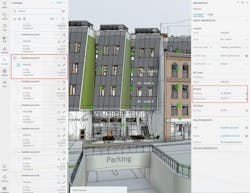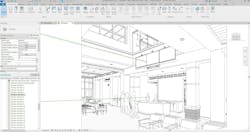This blog post was authored by Ryan Birkey, RA, Associate Partner, Senior Architect, Director of Innovation and Technology, Design Collaborative.
In the past decade, we’ve witnessed tremendous advancements in technology, and architecture hasn’t been left behind. One of the most exciting developments is the integration of artificial intelligence (AI) into architectural design and processes.
In a previous article, we discussed the cases for and benefits of Leveraging Artificial Intelligence in Architecture. AI is positioned to revolutionize the industry over the next five to ten years, from enhancing efficiency to optimizing designs. But what does this future look like?
The Short Term: AI in Architecture in 5 Years
In the next five years, AI will further embed itself into our architectural workflows, making us more efficient and effective in our designs. Here are some key ways in which AI will impact architecture in the short term.
Real-Time Design Optimization
AI tools can run test fits to optimize design configurations before a project progresses too deep into development. This means architects can quickly evaluate multiple options at a high level for clients to determine project feasibility and scope.
2D Content to 3D Model Generation
Imagine being able to convert a 2D image of your design into a functional 3D digital model. AI tools are evolving to make this possible, allowing us to better evaluate a design’s appearance and functionality.
AI-Powered Documentation
Currently architects and engineers are still delivering a set of construction documents to contractors, which enable them to construct a building. This requires a lot of documentation and detailing. AI can handle some of the mundane but crucial tasks in the design process, ensuring we have all the necessary content to complete a project smoothly. This not only improves efficiency but also reduces the likelihood of human error.
Code-Compliance Evaluation
Ensuring our designs comply with various codes—energy, accessibility, building, etc.—is critical. AI will soon be able to run real-time evaluations to ensure compliance, saving us time and effort.
The Long Term: AI in Architecture in 10 Years
Looking further ahead, predicting the exact impact of AI becomes a bit more challenging. However, several promising trends and technologies could redefine architecture over the next decade.
Building Generation Based on Precedent Data
By inputting or leveraging past project data, AI could generate floor plans, speeding up our processes significantly. AI could be trained on a firm’s past project and design data then be utilized to generate new content. Whether it be a style, unit layouts, project detailing, etc. AI will be able to help deliver design solutions that align with a firm’s design aesthetics.
3D Model Direct to Fabrication
Currently, construction documents are still the deliverable produced by architects. As BIM models become more advanced, AI can assist in closing that gap between the digital model and fabrication. More technologies will emerge to make the design and construction process more integrated and reduce time and waste throughout the process.
Real-Time Cost Data
With AI, we can input past and new data to help with cost evaluation. This would allow us to work with clients in real-time, changing materials or designs and seeing cost changes immediately, rather than waiting days for manual calculations.
Performance Optimization
AI will help bring about smart buildings that are more responsive to usage. Using sensors and other tools, AI could accurately gauge how a building operates and suggest ways to improve efficiency. Buildings and their systems will become more interconnected through IoT (Internet of Things) sensors and devices.
Keeping It Human in a Tech-Driven World
At Design Collaborative, our mission is to design People-First Places. While AI offers incredible tools to enhance our workflow, the heart of architecture remains the same—creating spaces that meet human needs.
By embracing AI, we can carry out our mission more efficiently and effectively.
Interested in learning more? Book a Speaker with us, and we’d be happy to share more on creating smarter, more efficient designs.
About the Author
Design Collaborative
Design Collaborative is an award-winning multi-disciplinary design firm founded in 1992, with the belief that through our work, we can improve people's worlds. With nationally recognized expertise and a passion for improving worlds, DC has grown to become consistently ranked amongst the top 100 firms in the country by staying focused on designing people-first places. At DC, we provide boutique firm experience with big firm expertise and resources. Our team includes architects, engineers, interior designers, cost estimators, graphic designers, and support staff. We are a one-stop solution, providing real-time collaboration and problem-solving. Follow Design Collaborative on Facebook, Instagram, and LinkedIn.



